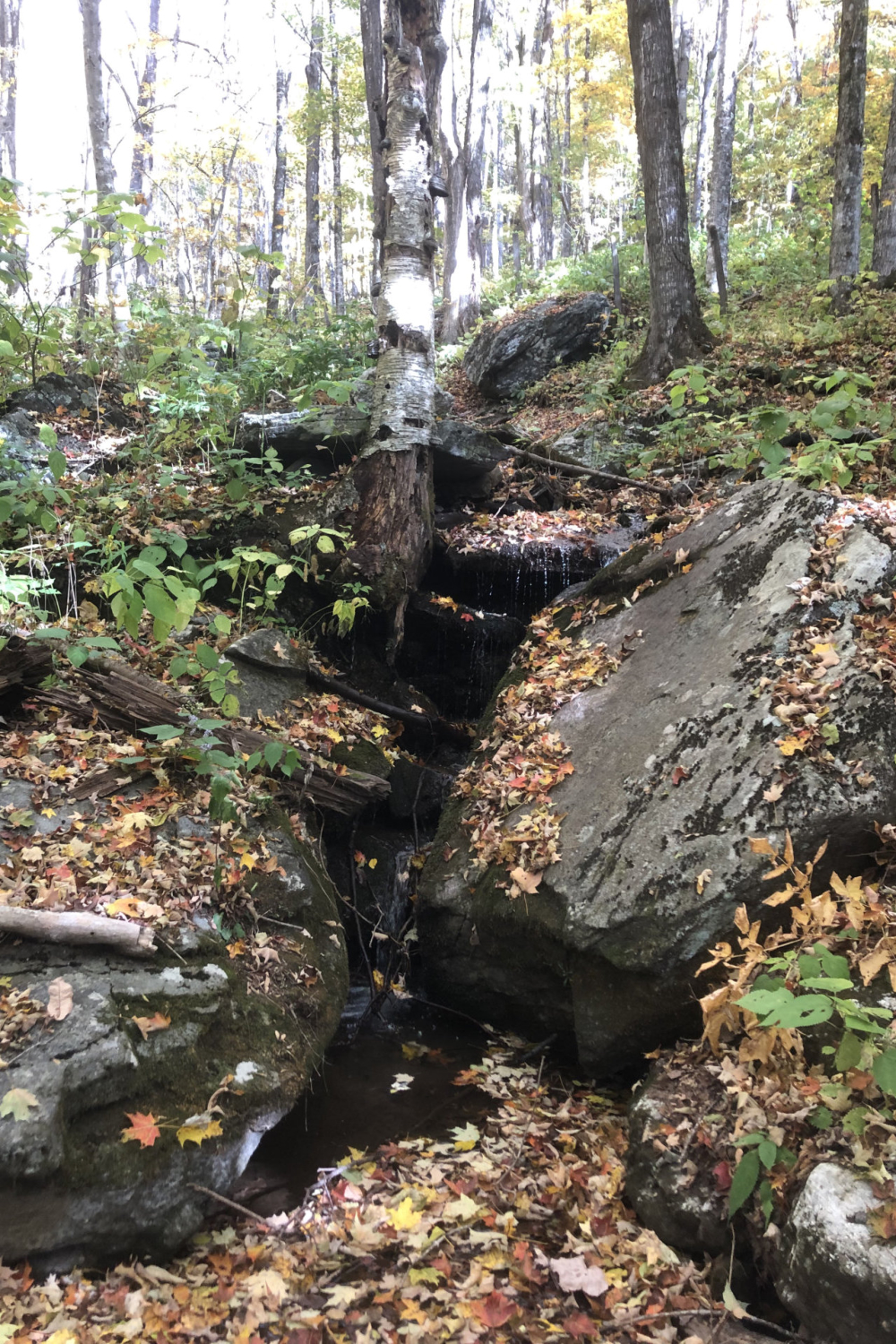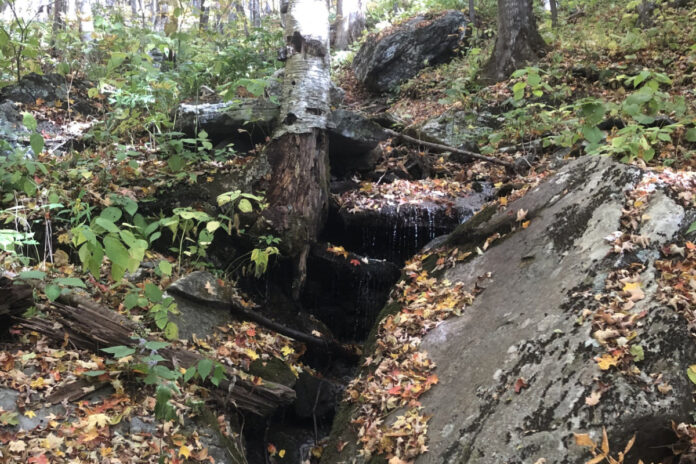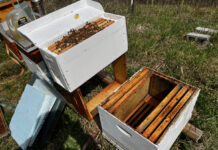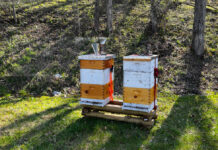I’ve been taking advantage of the cooler weather and the reduced amount of groundcover to extend my morning dog walks further into the surrounding mountains. Thursday’s trip started on an old logging road and required some bushwhacking down one valley and up to the other ridge as we cut over to another logging road to get us home.
On Sunday, I climbed 500 vertical feet, going higher up one of our local mountains than I had ever been before. This also included following an overgrown road which faded away. From that point on, I followed the remnants of an old fence line. It was so old most of the fence posts had rotted away, so all four or five rusty barbed wire strands lie on the ground. It can catch your foot and be a tripping hazard if you don’t pay attention. The old fence was clearly a property line. On one side was a piece of land that no one had logged for many decades with large, old-growth trees. I’m guessing that the other side was logged in the 1990s. It had much smaller trees and far more of them. Someone should be thin it to let the best ones grow.
The nice thing is that almost none of the local properties are posted no trespassing. I can confirm few people find their way up here. The road often intimidates out-of-towners who wander up here and they turn around rather than ford the stream. That’s the way we like it.
Following the Logging Roads
The logging roads are interesting because they often go up a mountain and split into two or three branches, each of which ends abruptly. They are not through roads but snake through someone’s property so the loggers could haul out the big tree trunks that represent the money part of the tree.
Some owners use their logging roads for recreational purposes such as hunting and riding four wheelers, but most are overgrown. The first one I used was littered with trees up to three or four inches in diameter. If the deer hadn’t used it and left a game trail, it would have been tough going. As it was, the dog and I both ended up covered with cockleburs.
Walking up the ridges and bushwhacking across valleys is interesting because we always find something we’ve never seen before. On Thursday we found a tiny waterfall I had never seen before (see the main image, above).
I’ve been carrying my water bottle, a hiking stick and my EDC gear. I’m thinking of carrying my Homestead Defense Pack so I can get used to the weight. It won’t be rigorous rucking, but it should help me get into better shape this winter. As it is, the dog is tired out for the rest of the day.
End of Season Chores
It hasn’t been all play and no work. We finally pulled the last of the vegetables out of the raised beds and fed the stunted zucchini and yellow squash to the chickens. Only one remaining zucchini was good enough for human consumption. We chopped up most of the plant and dumped it on the compost pile, although we fed some leaves to the chickens.
I then cleaned out the chicken coop, which created three wheelbarrow loads of the straw bedding packed with dried chicken poop. (We use what is called the deep bedding method. I’ve written about it prior, but you are welcome to Google it if you think letting chicken poop pile up in your coop sounds crazy.) I dumped this material into the raised beds and worked into the soil. We then covered it with a couple of inches of fresh dirt, planted our cover crop, and sprinkled more dirt over it before watering the beds.
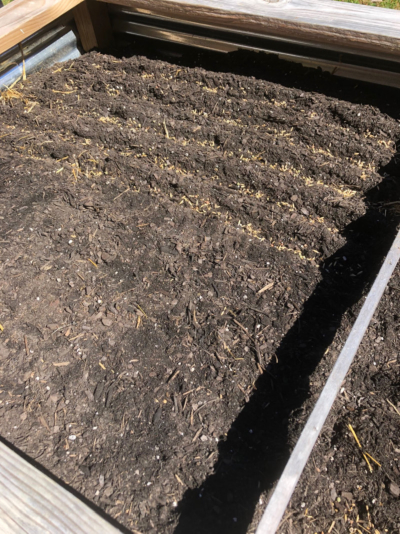
Cover Crop
I’ve never used a cover crop in a raised bed and am concerned that it will just create weeds in the spring. My wife wanted to try it and picked a special mix of seeds. I know better than to complain. The ground can use some nitrogen, and the cover crop, which includes peas, plus the chicken poop, should help. I think we would have had better results if we planted it a month ago when the soil was warmer. If we don’t get the result we want, we can return to covering the raised beds with leaves to protect the soil like we did last year.
It surprised me we had to add soil, but there was enough biomass in the beds that as it composted and broke down over the summer, the ground level inside the beds sank a few inches. We may need to add even more in the spring. It is healthy dirt with lots of worms.
The next time they predict a large snowfall, I’ll go to the farm supply store and buy 10 or 12 bags of top soil, raised garden bed mix, or whatever dirt they have left in stock in the middle of winter. They’ll look at me like I’m strange to buy dirt in January, but they’ll happily take my money and load the bags in the back of my pickup. The weight gives me better traction in the snow and I leave them in there a few weeks. Seeing as I’m going to be buying the dirt eventually, I might as well put it to use as ballast before I add it to the garden. I used this system last year, and it worked well.
Molting Chickens
The chickens have started molting and we’re getting fewer eggs. The Speckled Sussex have stopped laying almost entirely. It’s now a surprise when I get a light tan egg. The Red Stars have dropped production to where eight hens lay an average of six eggs per day. As your average backyard chickens go, that’s a good ration of eggs-to-chickens, but for this breed, it is low output. Until now, these girls have produced eight eggs almost every day. We should see production pick up after the winter solstice.
I have not yet screwed the acrylic window covers back over the screened windows of their coop, but the day is coming. I’m not going to worry about it until nighttime temps drop consistently into the 20s.
Final Bee Check
I took advantage of what may be the last day of sun and moderately warm temperatures to do a brief beehive inspection. In a few cases, I opened the hives and pulled out some frames for closer examination, but in most cases I just tilted back the box, noting its weight. The good news is that of the six hives, four were quite heavy and are in excellent condition, with lots of bees and a couple of frames of brood.
One hive, which was a split form earlier in the year, still had four empty frames in the top box. This is the only hive that I continued to feed with sugar syrup. The sixth hive was in decent shape, but didn’t seem to have as many bees as the others and it had not finished the last feeding. While this hive was a strong honey producer this summer, I think the queen is showing her age. I plan to re-queen it next year. If any of my hives fail to make it through the winter, I expect it might be this one.
The last “chore” I did as the temperatures dropped was to remove the snake shot round from my backup revolver and replace it with a JHP. There shouldn’t be any snakes around this late in the year.
I think we have completed our pre-winter chores. The only thing on my big to-do list that remains incomplete is some painting, and that’s not critical. If we get another warm day, I may yet squeeze that in.
